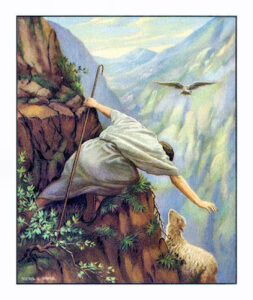The Face of God

What man of you, having a hundred sheep, if he has lost one of them,
does not leave the ninety-nine in the open country,
and go after the one that is lost, until he finds it?
(Luke 15:4)
By Stephen W. Hiemstr
The Lost Sheep (1898), a painting by Alfred Usher Soord (1868-1915), captured the enthusiasm of the great missionary movement of the late nineteenth century. The painting pictures a shepherd hanging off a cliff to rescue a lost sheep stuck on a limb in imminent danger of either falling to its death or being eaten alive by a circling eagle.
This painting tells a story and draws us in. But what is the story that this picture tells? Even though we cannot see the face of the shepherd in Soord’s painting, we immediately intuit that he is an honorable, trustworthy, and courageous man, someone devoted to his flock. Yet, we do not know his ethnicity, his religion, or even his age. Still, we want to emulate this shepherd as a role model.
For the believer, this painting evokes the image of an activist God who takes great risks to rescue sinners from impending death. We know this shepherd image from Psalm 23:1, which begins: “The Lord is my shepherd; I shall not want.” Jesus himself called on this image in John 10:14: “I am the good shepherd. I know my own and my own know me.” This image is poignant because we have more experience with bad shepherds than with good ones (Ezek 34).
Digging deeper into John 10, the story Jesus told may not be the one heard by modern and postmodern Christians. Jesus heals a blind man during the feast of Tabernacles (John 7:1), while the shepherd discussion takes place during the feast of Dedication (John 10:22), which like Hanukkah commemorates the re-dedication of the temple by Judas Maccabees in 165 BC. The Maccabees led a rebellion against the Hellenization of Israel and the desecration of the temple by Antiochus Epiphanies—a very bad shepherd! While today John 10 is typically read along with Psalm 23 (good shepherds), the context suggests that Ezekiel 34 (bad shepherds) is a better sermon text.
For the unbeliever, bad shepherds like Antiochus Epiphanies would be a more common experience than good shepherds and would clearly not be hanging off cliffs for lost sheep. In preparing to paint, Soord clearly read Ezekiel 34:45-6: “My sheep were scattered; they wandered over all the mountains and on every high hill.“ Unbelievers almost certainly would not see the allegory so obvious to most believers.
This is not a painting that leaves the viewer without an emotional response. Even a materialist might recognize the magnetism of this art. A cynic might scoff at the idea of the shepherd’s divine symbolism; a feminist might write it off the story because the shepherd is male. A first-century Jerusalem resident might easily have seen the shepherd as a shady figure—a poor, smelly beggar or thief—not a Sunday icon. A nonbeliever might reject the analogy obvious to believers as naive and work hard to come up with alternative narratives.
The point here is that Soord’s painting, like the parable itself, forces the viewer to accept or reject the theme of the painting. Jesus himself says: “This is why I speak to them in parables, because seeing they do not see, and hearing they do not hear, nor do they understand.” (Matt 13:13) The parable (and the painting) bring us into the presence of God and confront us with a decision of faith. Our hearts are either willing or not.
When Moses asked to see God’s face, God cautioned him to look only at the tail of his robe as he passed by. God then said: “The Lord, the Lord, a God merciful and gracious, slow to anger, and abounding in steadfast love and faithfulness.” (Exod 34:6) God’s face in the Old Testament was veiled, elusive, and seeing only God’s robe, Moses’ face began to glow (Exod 34:29). It is only in the person of Jesus and through his parables that we get a fuller picture.
The Face of God
Also see:
The Face of God in the Parables
The Who Question
Preface to a Life in Tension
Other ways to engage online:
Author site: http://www.StephenWHiemstra.net
Publisher site: http://www.T2Pneuma.com
Newsletter at: https://bit.ly/Enter_22, Signup
The post The Face of God appeared first on T2Pneuma.net.



